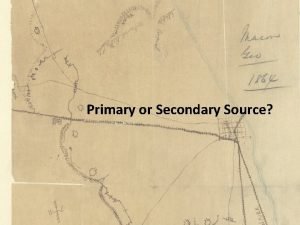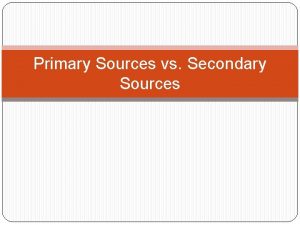Primary Secondary Sources Primary Source Firsthand information from









- Slides: 9

Primary & Secondary Sources

Primary Source: First-hand information from a person who witnessed or lived through an event. n Actual records that have survived from the past. n

Examples: n n n n n Diaries Memoirs Letters Photographs Official documents / records Manuscripts Newspapers Legal cases (transcripts) Interviews Oral histories • Personal narratives • Research data / reports • Statistics • Documentaries • Artifacts • Coins • Stamps

Analysis of Primary Sources n Some sources are more reliable than others. Since primary sources are taken during an event, they always have a bias, or slanted point of view in favor or against , the idea or concept at hand. Because of this, historians use certain rules to analyze primary sources to read them skeptically and critically.

Time and Place Rule n The closer in time and place a source and its creator are to an event, the better and more reliable the source will be. n Which is more reliable according to the time and place rule? n n A soldier’s letter home during WWII An interview with a WWII soldier 30 years after the war

Bias Rule n Every primary source is biased in some way. The creator’s point of view must be considered and also compared with other related sources. n Which is more reliable according to the bias rule? n n A diary A news report

Secondary Source: Description by a person usually not present at the event, relying on primary sources for information. n Usually analyze and interpret primary sources. n Accounts of the past created by people writing about the topic long after the events. n

Examples Novels n Non-fiction books n Encyclopedias n Textbooks n Research papers n Informational material – websites, TV shows, magazines, brochures, posters, etc. n

You. Tube Examples Pearl Harbor n n Primary speech/photos https: //www. youtube. com/watch? v=Yhtu. Mr. MVJDk Secondary https: //www. youtube. com/watch? v=yj. Mgv. Xhwi. WU Apollo 13 n n n Primary http: //www. youtube. com/watch? v=k 4 ek 9 g_e. N 0 Q Primary Interview http: //www. youtube. com/watch? v=1 e 4 f. Yb-zwd. E Secondary https: //www. youtube. com/watch? v=cz. P 0 a. YQf. NHk
 Primary secondary tertiary
Primary secondary tertiary What is a secondary source
What is a secondary source Distinguish between primary and secondary sources of light
Distinguish between primary and secondary sources of light Ecological succession
Ecological succession A primary source of light
A primary source of light Secondhand account
Secondhand account Is diary primary or secondary
Is diary primary or secondary Almanac primary or secondary source
Almanac primary or secondary source Secondary sources meaning
Secondary sources meaning Why autobiography is a primary source
Why autobiography is a primary source

















